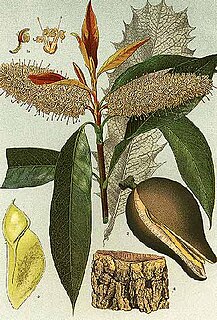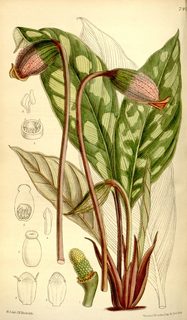
Freesia is a genus of herbaceous perennial flowering plants in the family Iridaceae, first described as a genus in 1866 by Christian Friedrich Ecklon (1886) and named after the German botanist and medical practitioner, Friedrich Freese (1795-1876). It is native to the eastern side of southern Africa, from Kenya south to South Africa, most species being found in Cape Provinces. Species of the former genus Anomatheca are now included in Freesia. The plants commonly known as "freesias", with fragrant funnel-shaped flowers, are cultivated hybrids of a number of Freesia species. Some other species are also grown as ornamental plants.

Grevillea, commonly known as spider flowers, is a genus of about 360 species of evergreen flowering plants in the family Proteaceae. Plants in the genus Grevillea are shrubs, rarely trees, with the leaves arranged alternately along the branches, the flowers zygomorphic, arranged in racemes at the ends of branchlets, and the fruit a follicle that splits down one side only, releasing one or two seeds.

The genus Huernia consists of perennial, stem succulents from Eastern and Southern Africa and Arabia, first described as a genus in 1810.

Persoonia, commonly known as geebungs or snottygobbles, is a genus of about one hundred species of flowering plants in the family Proteaceae. Plants in the genus Persoonia are shrubs or small trees usually with smooth bark, simple leaves and usually yellow flowers arranged along a raceme, each flower with a leaf or scale leaf at the base. The fruit is a drupe.

Xylomelum is a genus of six species of flowering plants, often commonly known as woody pears, in the family Proteaceae and are endemic to Australia. Plants in this genus are tall shrubs or small trees with leaves arranged in opposite pairs, relatively small flowers arranged in spike-like groups, and the fruit a woody, more or less pear-shaped follicle.

Isopogon, commonly known as conesticks, conebushes or coneflowers, is a genus of about forty species of flowering plants in the family Proteaceae, and are endemic to Australia. They are shrubs with rigid leaves, bisexual flowers in a dense spike or "cone" and the fruit is a small, hairy nut.

Xyris is a genus of flowering plants, the yelloweyed grasses, in the yellow-eyed-grass family. The genus counts over 250 species, widespread over much of the world, with the center of distribution in the Guianas.

Nicholas Edward Brown was an English plant taxonomist and authority on succulents. He was also an authority on several families of plants, including Asclepiadaceae, Aizoaceae, Labiatae and Cape plants.

Duvalia is a succulent plant genus in the subfamily Asclepiadoideae, in the family Apocynaceae (dogbane).

Caralluma is a genus of flowering plants in the family Apocynaceae, consisting of about 120 species.

Petrophile is a genus of evergreen shrubs, in the family Proteaceae. The genus is endemic to Australia. Commonly known as conebushes, they typically have prickly, divided foliage and produce prominently-displayed pink, yellow or cream flowers followed by grey, conical fruits.

Piptospatha is a genus of flowering plants in the family Araceae. The genus is characteristic is rheophytic and has seeds that are dispersed by splashes of water hitting its cup-like spathes. It is native to Southeast Asia.
- Piptospatha burbidgei(N.E.Br.) M.Hotta - Sarawak, Sabah
- Piptospatha elongata(Engl.) N.E.Br. - Kalimantan Barat
- Piptospatha impolitaS.Y.Wong, P.C.Boyce & Bogner - Sarawak
- Piptospatha insignisN.E.Br. - Sarawak
- Piptospatha manduensisBogner & A.Hay - Kalimantan Timur
- Piptospatha marginata(Engl.) N.E.Br. - Sarawak
- Piptospatha perakensis(Engl.) Ridl. - southern Thailand, Peninsular Malaysia
- Piptospatha remiformisRidl. - Sarawak
- Piptospatha repensH.Okada & Tsukaya - Kalimantan Barat
- Piptospatha ridleyiN.E.Br. ex Hook.f. - Johor, Pahang, Selangor
- Piptospatha truncata(M.Hotta) Bogner & A.Hay - Sarawak
- Piptospatha viridistigmaS.Y.Wong, P.C.Boyce & Bogner - Sarawak
Several genera share the name Anisopus:

Paranomus is a genus of 18 species of flowering plants, commonly known as "sceptres", in the protea family. It is endemic to the Cape Floristic Region of South Africa.
Glossostelma is a plant genus in the family Apocynaceae, first described as a genus in 1895. It is native to Africa.
- Glossostelma angolenseSchltr. - Angola
- Glossostelma brevilobumGoyder - Zaïre, Burundi, Tanzania, Malawi
- Glossostelma cabrae(De Wild.) Goyder - Zaïre
- Glossostelma carsonii(N.E.Br.) Bullock - Gabon
- Glossostelma ceciliae(N.E.Br.) Goyder - Zimbabwe, Mozambique
- Glossostelma erectum(De Wild.) Goyder - Zaïre
- Glossostelma lisianthoides(Decne.) Bullock - Angola
- Glossostelma mbisienseGoyder - Tanzania
- Glossostelma nyikenseGoyder - Malawi, Zambia
- Glossostelma rusapenseGoyder - Zimbabwe
- Glossostelma spathulatum(K.Schum.) Bullock - Angola
- Glossostelma xysmalobioides(S.Moore) Bullock - Angola













